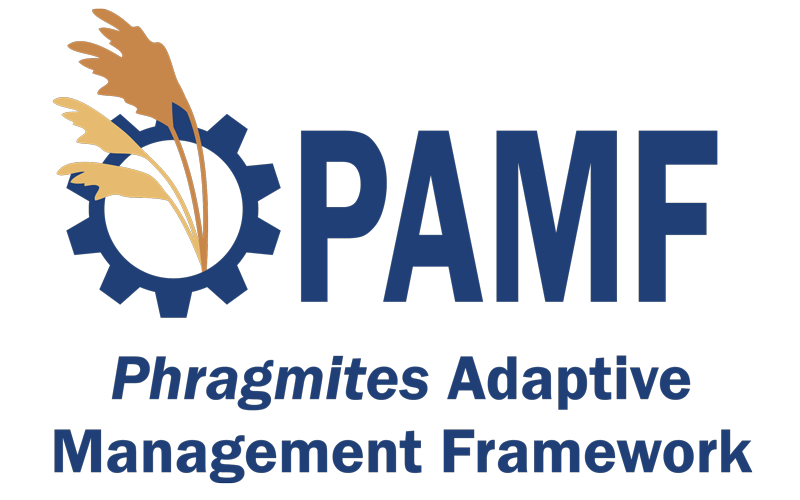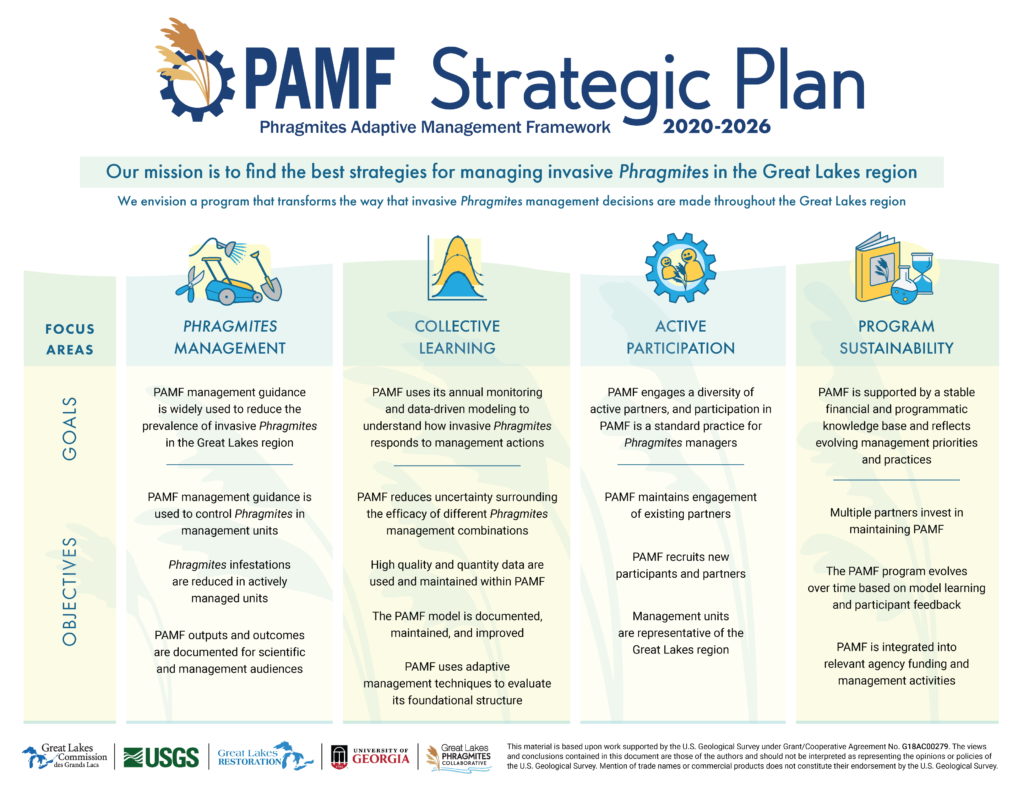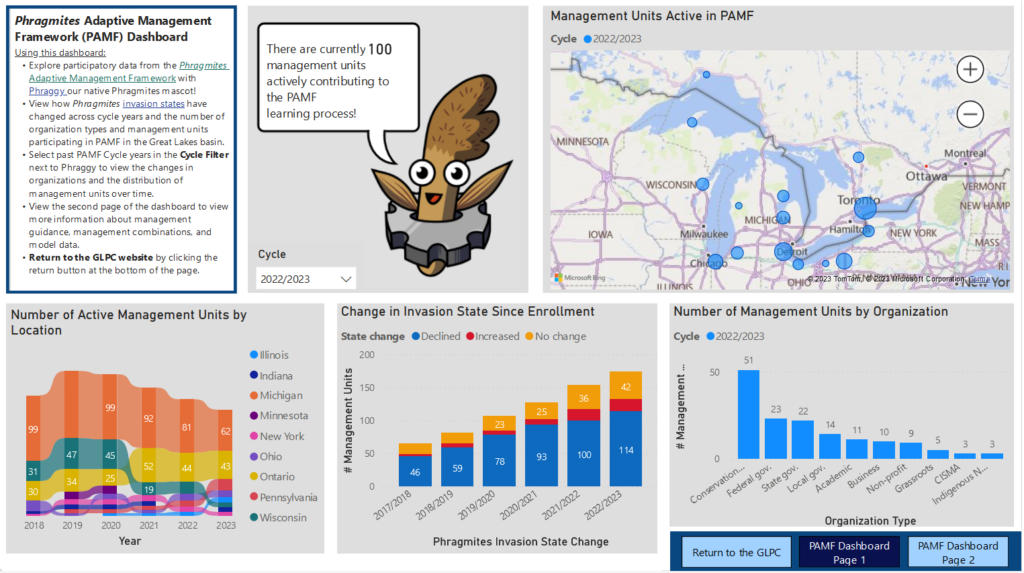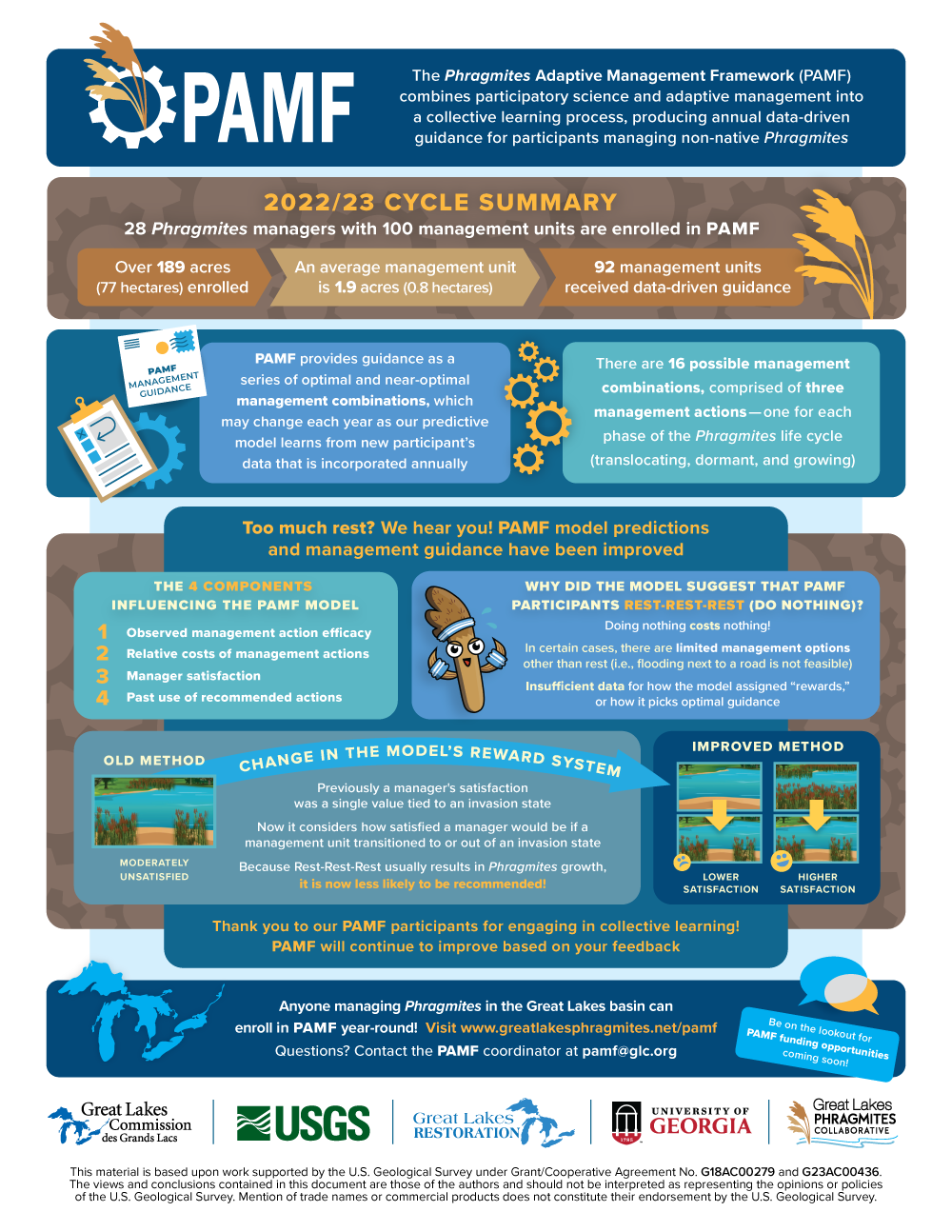

About PAMF
Non-native Phragmites australis is one of the most aggressive plant species invading North America and is already well established in the Great Lakes basin, along the Atlantic, Pacific, and Gulf Coasts, and around the Great Salt Lake. More about Phragmites can be found here.
Non-native Phragmites is managed using a suite of conventional approaches (e.g., herbicide, cutting/crushing, flooding, burning), but these approaches aren’t getting the job done at the landscape scale. These management actions are resource intensive and differ in effectiveness, largely because there are uncertainties about how the plant responds to treatment given site-specific conditions and variations in how managers implement control efforts. Moreover, managers often disagree on what outcomes can be expected from Phragmites control efforts. In addition, it is difficult to coordinate management efforts across the landscape and to disseminate what we can learn from every action taken across the broad scale of site characteristics and invasion states.
To address these challenges, the Great Lakes Phragmites Collaborative developed an adaptive management strategy called The Phragmites Adaptive Management Framework (PAMF). This framework will change the way Phragmites management is done throughout the Great Lakes basin and lead to approaches that maximize the effectiveness and efficiency of Phragmites management.
What is PAMF?
PAMF is an adaptive management and collective learning program that anyone managing Phragmites can join. Participants from around the Great Lakes basin submit Phragmites monitoring and management data to bolster the PAMF predictive model, which uses participant data to continually ‘learn’ more about which management techniques are working to reduce Phragmites infestations and which ones are not. In turn, the PAMF model predicts optimal management guidance for each site being managed based on the most up-to-date information collected from all the participants. This process repeats annually, reducing uncertainty with additional data collected. By undergoing this collective learning process, we can determine which management techniques are efficient and effective for controlling Phragmites quicker than if we were working alone. The goal of PAMF is to determine best management practices for Phragmites in the Great Lakes.
For more information on how PAMF works, watch our short videos and descriptions on the PAMF Participant Cycle.
What does a PAMF participant do?
The PAMF Participant Cycle

1. Enroll a Management Unit (MU)
PAMF runs on an annual cycle, but anyone who wants to manage Phragmites can become a participant at any time of the year! They first enroll a management unit (MU), or site they’d like to manage, by providing some basic background information on the site’s habitat, prior management, size, and any management limitations (e.g., due to policy, they cannot use herbicides).
2. Monitor Phragmites in the MU
The participant monitors the MU once a year in July for Phragmites stem density and establishment, along with a few other variables. We provide the few simple tools participants need for free!
3. PAMF Model learns from data
Monitoring data is fed into the PAMF computer model, which takes all of the monitoring and management data collected by program participants and annually learns more and more about which management techniques work best under different conditions and for the least cost.
4. Receive management guidance
The PAMF model generates site-specific management guidance that is sent to participants for every MU they monitored. Guidance provides participants with what kinds of management actions to apply to their MU(s) during the fall (‘translocating phase’ of Phragmites), winter (dormant phase), and spring/summer (growing phase) to reduce Phragmites infestation.
5. Manage Phragmites in the MU
Participants manage their MU over the rest of the year by following guidance (or implementing any other management action they choose) and submit management data during each season.
PAMF Mission and Vision
PAMF 2020-2026 Strategic Plan
This strategic plan will guide successful implementation of PAMF by setting program-specific goals, objectives, and measures for the next five years. The PAMF core science team that developed the plan includes representatives from the Great Lakes Commission, U.S. Geological Survey, and University of Georgia. The core science team will evaluate the status of PAMF annually against this strategic plan. Unless otherwise stated, the plan goals, objectives, and measures are designed to be achieved at the end of the five-year plan period, and overall progress will be measured at the end of the 2025/26 PAMF cycle.
Download the full PAMF Strategic Plan here!
Outcomes of Using PAMF
- PAMF will unite resource managers, researchers, and other stakeholders and facilitate successional learning through a collaborative information sharing system that contains an evolving and collective understanding about how to best treat Phragmites
- PAMF will promote cooperative, transparent decision making to reduce uncertainty regarding the effectiveness of management
- PAMF is a cost-and time-efficient way to address a large, regional-scale problem
PAMF Information Dashboard
The PAMF dashboard was created to display a snapshot of the PAMF program and display information about the who, what, and where of Phragmites management in the Great Lakes basin. While exploring the dashboard, filter the data with embedded drop-downs to change the data displayed. For more information on PAMF, management combinations, and model guidance explore the history and development of PAMF.
Click the image below to open the dashboard in a new tab.
PAMF Cycle Summary
PAMF Science Advisory Team
Great Lakes Commission
Samantha Tank
PAMF Coordinator
Project Manager
sam@glc.org
Erika Jensen
Executive Director
ejensen@glc.org
Theresa Gruninger
Senior Program Specialist
tgruninger@glc.org
Taaja Tucker-Silva
Senior Data Analyst
taaja@glc.org
Nichole Angell
Program Specialist
nangell@glc.org
U.S. Geological Survey
Kurt Kowalski
Research Wetland Ecologist
USGS – Great Lakes Science Center
kkowalski@usgs.gov
Clinton Moore
Unit Leader (Acting), Adjunct Associate Professor, Wildlife Ecology and Management
USGS – Georgia Cooperative Fish and Wildlife Unit
Retired
Christine Dumoulin
Biologist
USGS – Eastern Ecological Science Center
cdumoulin@usgs.gov
University of Georgia
Chuck Bargeron
Senior Public Service Associate & Co-Director
Center for Invasive Species and Ecosystem Health (Bugwood)
cbargero@uga.edu
Technical Working Group
Technical Working Group
PAMF was developed by a Core Science Team composed of researchers and staff at the USGS, University of Georgia, and the Great Lakes Commission. The Core Science Team worked closely with a Technical Working Group (TWG), which was made up of experts in Phragmites management representing different stakeholder values, priorities, and perspectives. Involving the TWG at an early stage ensured that the final framework reflected the needs and objectives of end-users. Members of the TWG remain involved in PAMF today. Although their roles have changed, these individuals continue to volunteer their time and offer their advice and expertise. PAMF could not exist without them.
We would like to acknowledge the following individuals and organizations:
Linda Nelson, U.S. Army Corps of Engineers
Greg Norwood, Michigan Department of Natural Resources – Wildlife Division
Anne Garwood, Michigan Department of Environmental Quality
Jennifer Dunn, New York State Department of Environmental Conservation
Tom Arbour, Ohio Division of Natural Areas and Preserves
Jason Granberg, Wisconsin Department of Natural Resources
Jason Hill, Ducks Unlimited
Janice Gilbert, Wetland Ecologist, Invasive Phragmites Control Centre
Bobbie Webster, University of Wisconsin Green Bay, Cofrin Center for Biodiversity
Rebecca Rooney, University of Waterloo, Department of Biology
Bob Williams, Clay Township Phragmites Advisory Board ; Stewart Farm Ecology Center, Director
Lisa Brush, The Stewardship Network
Jake Bonello, U.S. Fish and Wildlife Service, Klamath Basin National Wildlife Refuge Complex

Additional Resources
PAMF Brochure
This brochure provides a short overview of PAMF and highlights several benefits the program can provide. Please contact us for print copies.
MONDRIAN
There are multiple tools available to help managers make the best Phragmites management decisions possible. In addition to PAMF, you may have also heard of the MONDRIAN management support tool. Check out this comparison document to learn the differences between the two tools.
Join PAMF
Anyone managing non-native Phragmites in the Great Lakes basin can participate in PAMF. Click the button below to get started!
Questions?
Please contact: Samantha Tank, Great Lakes Commission at pamf@glc.org






